| . | . | . | . |
web'Galerie Voigt Edition |
| France F - 32320 Bassoues , Grande Rue |
| craftmanship | blockletter-printing | collotype | lithograpy | giclée | gallery home |
lithography - a quick information
In 1800 A. Senefelder invented the basic effects of lithography and continue in working on this process in order to duplicate musical-score in an easy way. He found that he could stabilise the behavior of limestones with gum-arabic to water so he managed to do a great number of prints without serious problems.
The main effect of this method depends on the behavior between grease and water. The elements to be printed were oily ones. The space between them must save water so they take no printing-ink during the inking-process of the stone.
At the days of blockletter-printing the way of realising a drawing as lithopgraphy was much easier than doing it as woodcut. On the stone you can do your drawing with normal artist-material e.g. with oily pencils. You can even draw with oily ink on paper and print this image on a stone so your lithographie was ready for praeparation. Duplicating lithography-stones is possible in the same manner. Later on the lithography was involved by the process of photography. Doing a chromo-lithographie is copying a photography on stone using lightensitive asphalt.
After transfering the Senefelder-process on metalplates the offsetprinting is the most popular printing process in our industrial age. Only the newest waterless process got nothing to do with Senefelder-technology, it depends on the adhäsion of silicone and metal.
Artists today usually use aluminium-plates for they can do the printing on modern machines, but on the original litho-stones you have more possibilities.You can do your drawing not only in an carbon-style, with a lavis it's possible to work in a fine halftone greyscale, if you have a good experience in etching.
lithography at the Atelier de Séguret
This documentation was done by the artist Sonja Wallerius in the Atelier de Séguret in France / Provence. The ateliers are open for every artist and eachone can get as much experience as he wants in the original Senefelder-process. The whole historical equipment is carefully chosen and in excellent condition.
praeparing a stone for the drawing
The litho-stone is not even grinded to create an even surface, for the cemical praeparation of the older drawing had to be totaly removed.

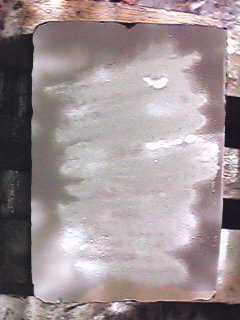
The grain of the abrasive and the type of stone are related to the quality of surface you can get. A grain of 240 is good for easy polishing and good enough for all general applications.
The abrasive is brought on the surface of the litho-stone and then you add not too much water.


After this you put an second stone on it and start moving it in circles without extra pressure to distribute the abrasive. You continue grinding that way until the stones begin to get dry. You realise that circumstance of course you will need more strenght to move the stone. You break add more water to your abrasive and continue grinding .
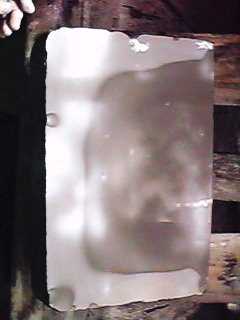
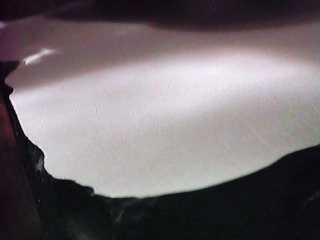
You can see the result of your operation after washing the stone and dry it. Of course under this circumstance any grease on the stone is seen as a dark spot.
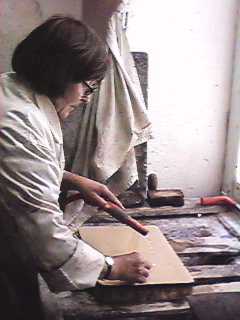
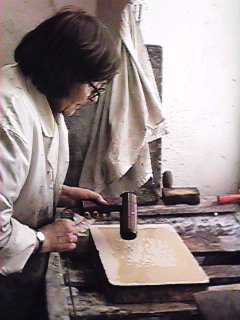
At the end the stone is carefully cleaned and dry - ready to use.
the drawing

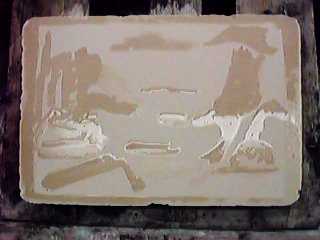
In this case the artist starts with protecting free areas with a solution of gum-arabic. When this solution is dry, the gum-arabic is in a cemical connection with the stone with loves only water and you can clean it from grease with pure water.
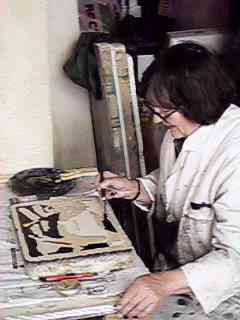
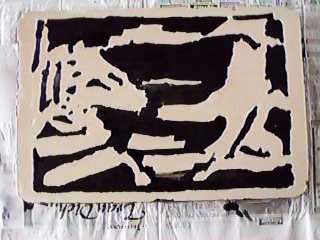
So the litho-ink of the dark drawing in the second step have no chance to change the protected fields.
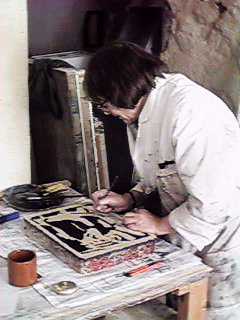
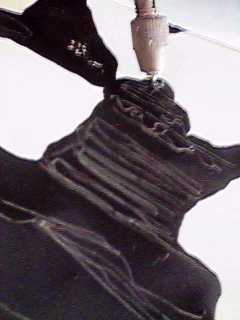
Now the artist do a light drawing in the dark fields of litho-ink. In this case you only have to remove the ink e.g. with a needle it's not necessary to get deep in the stone's surface. Of course you do brighten the light drawing by the use of phosphor-acid. During this operation even areas with has been coated with thin litho-ink were washed away.
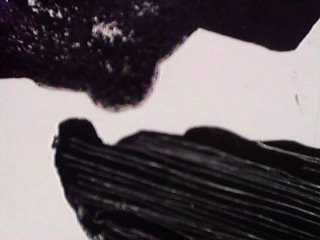
This is the way you generally treat a lavis, but you need much experience in the relation of how much greace your litho-ink must have and what acid-solution you use.
praeparation of the litho-stone

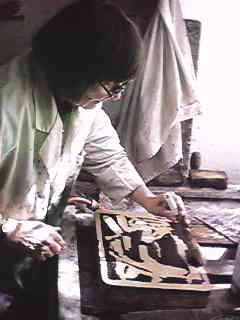
The drawing on the stone had to be protected with powder of colophonium and then with talkum. Then you cover the whole stone with your etching, a solution of gum-arabice and a little acid. After 24 hours the cemical process had stabilisised the "waterloving" areas.
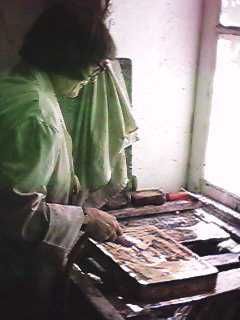
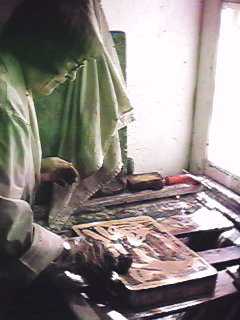
The other day you clean up the stone with water. Now it's important to stabilisise the oily printing elements. Therefore you wash away the grease of your drawing wich is not in conclusion with the stone using terpentin. Your drawing disappear in main only a light image is seen. To bring is up you rub the stone with an asphalt-solution. As result you get a totally spoiled image of your drawing. But if Senefelder was right, you can clean it up with pure water and I think he is.

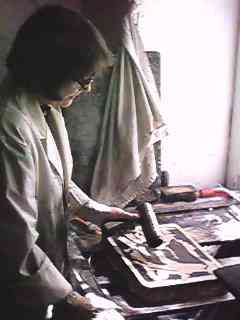
Now you ink the wet stone with a special greace-ink and your drawing give a bright image on the stone's surface.
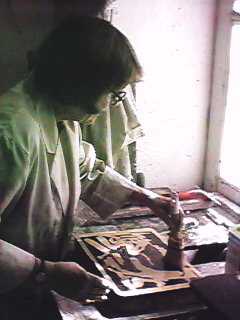
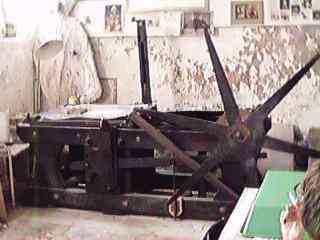
After drying the stone you apply once more an etching-solution, so that the old printing-machine aged 130 years have to wait one more day.
the printing


Printing is done from the wet stone. Don't use too much water, you will get problems with the printing-ink (gray prints).
After inking the stone you can clean it up with your water-sponge.
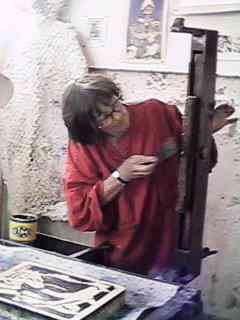

Greasing the pressure-part and the protectionshield.
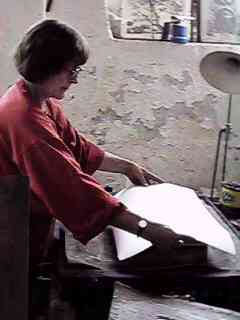

Applying the printing-paper and one protection-paper.
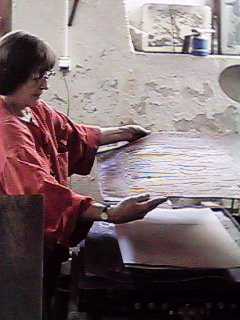
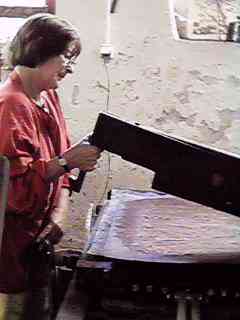
Applying the greased protection-shield and closing the pressure-part.


Holding down the lever-arm for the pressure to print and moving the stone trough the printing-machine
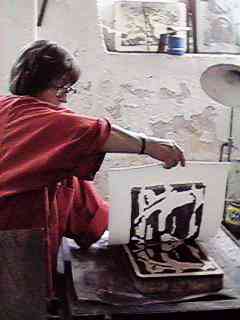
Taking the lithography. It's that what I want ?
| 1. scriptrevision 12.08.97 - copyright - web'Galerie Voigt Edition |
| craftmanship | blockletter-printing | collotype | lithograpy | giclée | gallery home |
16859 visitors since 25.04.98